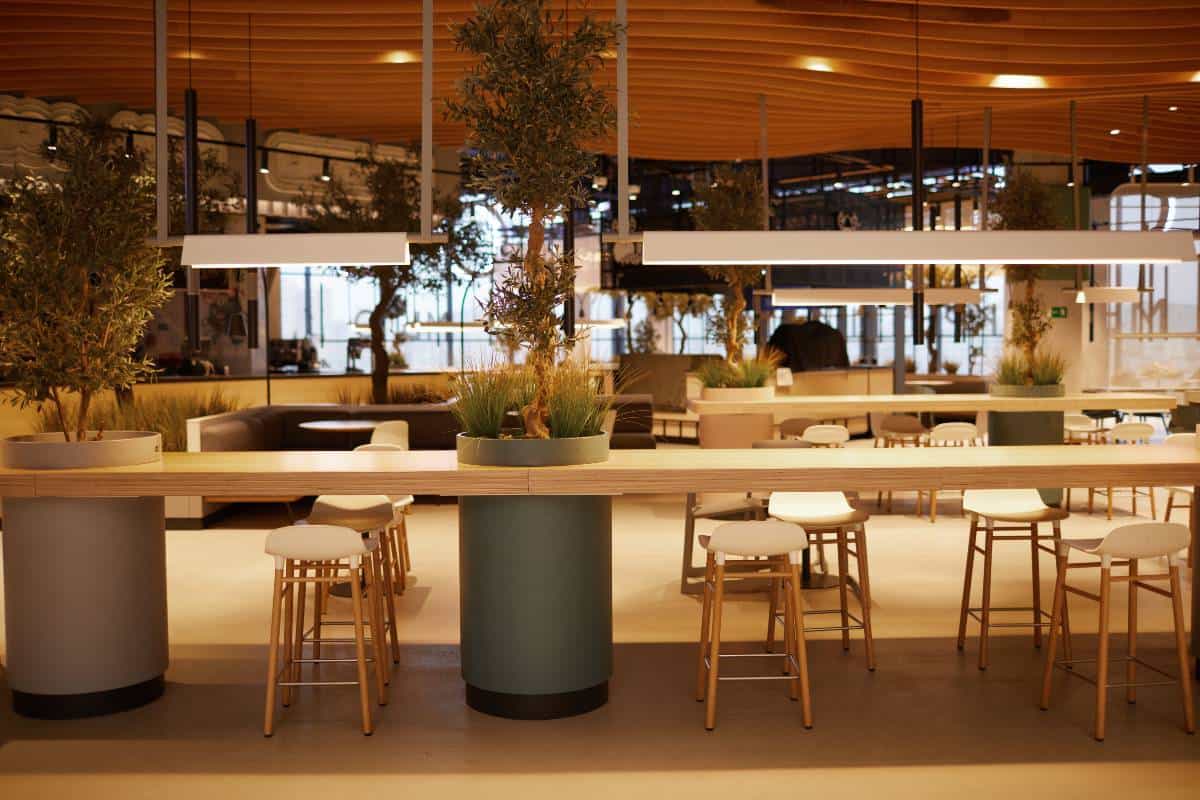As a commercial real estate specialist with over 18 years of experience, I’ve seen the retail landscape transform dramatically. Food halls, in particular, have emerged as an extremely popular model, appealing to changing consumer tastes and behaviors.
Unlike the food courts of old, modern food halls feature artisanal eateries and emerging chefs serving an eclectic mix of cuisines – from ramen to tacos to poke bowls. It’s a foodie paradise under one roof. Patrons can grab a drink at the central bar, and then freely sample from the diverse restaurant concepts on display.
So what’s behind the recent explosion of these culinary hubs? Let’s explore the key factors making food halls an unstoppable real estate trend.
Key Takeaways
- Food halls have shown resilience during COVID, with less than 10% permanently closing
- Younger consumers are drawn to the variety of cuisines and experiences
- Real estate owners use food halls to attract tenants and reactivate unused space
Table of Contents
The Enduring Allure of Food Halls in a Post-Pandemic World
Resilient Model During COVID
If the pandemic has taught us anything, it’s to appreciate adaptability in turbulent times. Food halls have proven far more crisis-resilient than expected:
- More than 10% permanently closed doors in 2020-2021
- Today over 50% are fully operational again
- New hall openings accelerate across US markets
That durability arises from the flexible nature of the food hall business model. Multiple small vendors share infrastructure costs for seating, utilities, dishwashing, and storage.
If one struggling operator leaves, owners can easily slot a replacement tenant into modular stall space. Landlords also benefit from built-in crowds curious to sample the regularly rotating concepts.
Perfectly Tailored Dining Experiences
Modern consumers, especially millennials, crave immersive social experiences as much as great food. They want Instagrammable meals that tell a story. Food halls deliver unique vendor collaborations and event programming.
The variety also appeals to groups with diverse tastes – picky kids, vegetarian friends, and global flavor seekers. No more arguing over the same old chain restaurant choices!
Revitalizing Retail and Real Estate
Shopping malls and office towers utilize the future of dining– food halls to attract clientele, activate unused floors, and enhance amenities. The grab-and-go ease caters nicely to time-pressed professionals as well.
These projects allow young chefs and minority/women-led concepts to launch brick-and-mortar spaces cost-effectively too. Many parlay food hall popularity into their thriving outlets.
Innovations That Elevate Experiences
Successful food halls can’t stand still. They test creative ideas to keep attracting urban explorers seeking novel dining adventures. Some emerging trends:
Daypart Expansion
- More morning fare beyond just pastries and coffee
- Breakfast tacos, loaded omelets, acai bowls
- Savory sandwiches, veggie-centric grain bowls
The bustling weekend brunch service makes sense. Yet neglected late-night and afternoon crowds present expansion opportunities as well.

Creative Entertainment Integrations
- Arcades, bowling alleys, escape rooms
- Themed events like trivia and karaoke nights
- Cooking demos from resident chefs
- Live music showcasing local artists
As online ordering for takeout or delivery climbs, food halls explore engaging experiences that can’t be replicated digitally at home.
Targeted Community Building
- Spotlight women or minority-owned businesses
- Accommodate religious dietary codes
- Host cultural food festivals
Culinary concepts should reflect the fabric of the neighboring community. Leaning into that hyperlocal identity fosters loyal patronage.
Optimizing Layout and Equipment
While dreamed-up concepts energize patrons, we can’t forget pragmatic operational considerations. Poor layouts lead to bottlenecks and subpar tenant performance.
Flexible Shared Infrastructure
Efficient behind-the-scenes infrastructure serves as the lifeblood for smooth service. Food halls generally install:
- Modular stall widths
- Standardized equipment across vendors
- Ample electrical and ventilation
- Shared dishwashing and storage
These back-of-house optimizations allow for easily interchanging new operators if needed.
Comfort Focused Front-of-House
Given over 50% of patrons dine in the communal areas, comfort reigns supreme. Thoughtful seating configuration avoids congestion while encouraging social interaction.
Safety First
After the pandemic, consumers demand stringent safety as an expectation, not a bonus. Signage should mark pick-up points while providing enough space for distancing in queues.
Touchless payment methods and frequent sanitization also provide visible peace of mind.
Suburban and Rural Opportunities
Most discussions surrounding food halls focus on densely populated urban areas. But underserved markets in smaller cities and towns hunger (pun intended!) for eclectic dining as well.
Raising Consumer Awareness
The main hurdle is letting potential customers know about the area’s best-kept secret foodie gem. Aggressive social media outreach and geo-targeted digital ads help enormously.
Infrastructure Constraints
Equipment like ventilation for cooking demo areas may exceed capacity for older strip mall build-outs. Careful tenant selection for low-infrastructure cuisine can circumvent limitations.

How Food Courts Are Adapting to Shifting Consumer Expectations
The traditional food court model faces rising competition from trendy food halls. But savvy owners are responding with tactical innovations to stay relevant.
Embracing Local Food Trends
Many properties now curate homegrown eateries alongside national quick-service restaurants. Showcasing neighborhood chefs and cuisines builds community loyalty. Food courts also host pop-up events for diners to sample new local vendors.
Enhancing Food Court Ambiance
Grease-laden corridors receive contemporary facelifts with chic lighting, stylish furniture in lounge areas, and murals or plant walls to soften hard surfaces. Charging stations and free wifi transform pit stops into hangout spots.
Incorporating Street Food and Food Truck Concepts
Street eats like loaded fries, fusion tacos, and chicken & waffles migrate from outdoor festivals into the air conditioning. Food truck chefs known for long lines pilot brick-and-mortar outlets.
Integrating QSR Innovations
Takeout and delivery grab attention, but food courts also test self-ordering kiosks, customizable burger stations, and virtual reality games. Some connect rewards programs through a centralized mobile app.
Exploring Food Chain Partnerships
Regional fast food favorites or emerging ghost kitchen chains fill vacancies faster than independent build-outs. Their marketing budgets and operational expertise minimize risk.
Are Food Halls the Future of Dining and Entertainment in Commercial Properties?
As a commercial real estate specialist, I’m often asked if food halls are just a fad or where to stay. Based on all the evidence, I firmly believe they will only grow in popularity over the next decade!
The Future of Food Halls in 2023 and Beyond
We’ll see sleek new food halls incorporated into office redevelopment projects, apartment buildings, and hotel atriums – anywhere owners want to provide modern dining experiences. Expect expanding footprints in suburban neighborhoods too.
Benefits of Food Halls in Mixed-Use Developments
These adaptable, lively eateries activate ground-floor retail in condos or medical centers. They attract office workers during weekdays and residents on evenings/weekends with programming like comedy shows.
The Unique Allure of Food Halls for Shopping Mall Visitors
Malls jump on the trend to give shoppers hip new food options beyond tired food court staples. Food halls also keep patrons lingering longer, converting impulse stop-offs into destination dining.
The Transformation of Food Courts into Modern Food Halls
Aging malls refurbish outdated or shrinking food courts by bringing in chef-driven stalls, full bars with craft beer, and comfy lounge furniture. More like a chic market than a grab-and-go pit stop!
Insights into the Evolution of Food Vendors in Commercial Real Estate
As consumer palates grow more adventurous and ethically-minded, food vendors diversify – from Afro-Caribbean flavors to allergen-free bakeries. Landlords curate the right merchant mix.
The days of Chicken Tenders Palace dominating food service options fade rapidly. tenants and shoppers demand specialty culinary discoveries – which versatile food halls deliver perfectly!
FAQs
What’s the difference between a food court and a food hall?
Food courts feature quick-service national chains versus independent artisans. Halls boast higher quality and trendier fare in an upscale setting.
What vendors are best suited for the food hall model?
Takeout-friendly cuisines like burgers, pizza, and build-your-own bowls see success. Breweries, dessert stalls, and specialty coffee shops complement savory vendors.
How many stall spaces should a typical food hall incorporate?
Ideally between 10-15 operators. Too few lacks variety while excessive diversity causes choice paralysis. Balance local hero restaurants with regional exports.
What percentage of rent do food hall owners typically collect from vendors?
Industry-standard hovers around 10-15% gross sales. Sweeten the deal for sought-after or anchor tenants with discounts of around 8%. Surcharges for highly trafficked zones.
What role do food halls play in the evolution of QSRs and casual dining?
Food halls influence the evolution of QSRs and casual dining by offering a platform for established brands and emerging concepts to expand their presence, experiment with new formats, and engage with customers in a vibrant and communal environment.
How are food halls contributing to the transformation of the food service and hospitality industry?
Food halls contribute to the transformation of the food service and hospitality industry by fostering innovation, collaboration, and creativity among food vendors, creating new opportunities for local and artisanal food producers, and redefining the concept of communal dining and social gatherings.
Conclusion
Food halls are hot right now. People love the cool mix of different restaurant choices altogether. Real estate owners use them to bring in more visitors.
I’m excited to work with business owners to create awesome new food halls.
With over 18 years of guiding clients, I handle everything – finding the ideal location, designing the layout, getting city approval, and even attracting great chef tenants.
My thoughtful advice is free. No pressure or obligations.
Want to bounce around some fun food hall ideas? Schedule a consultation and chat about what you imagine. It costs nothing to explore possibilities!
It’ll help turn your big idea into a real spot people flock to 7 days a week. Let’s make it happen!




